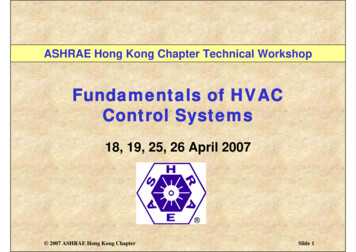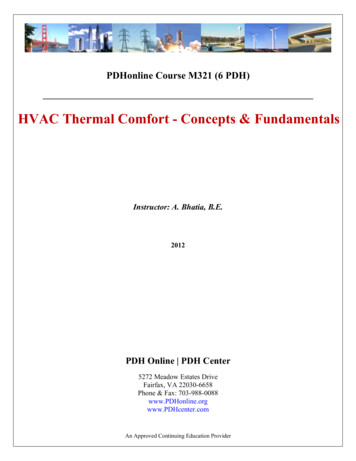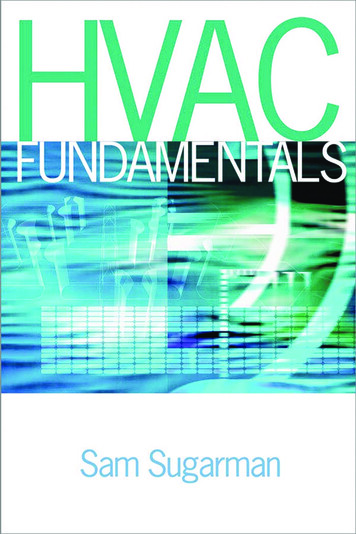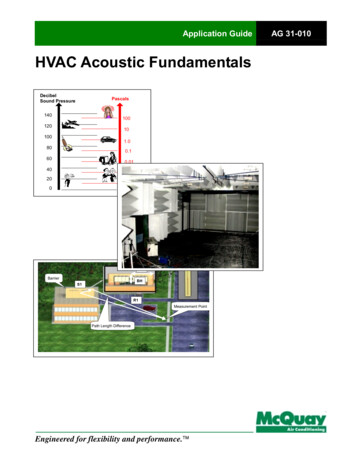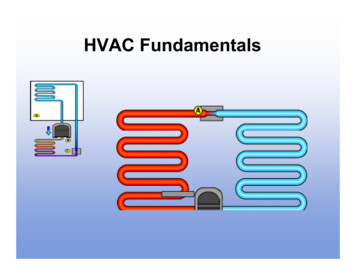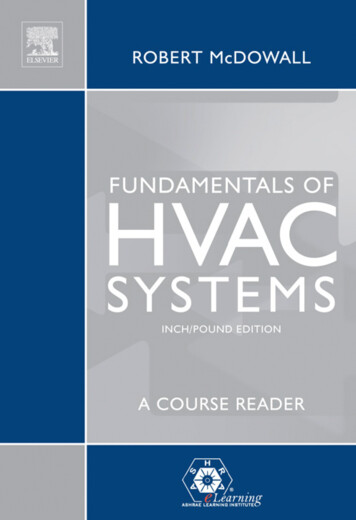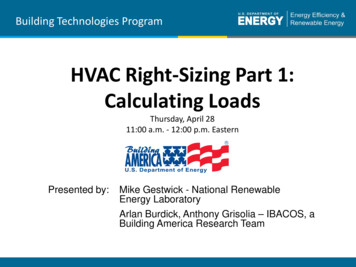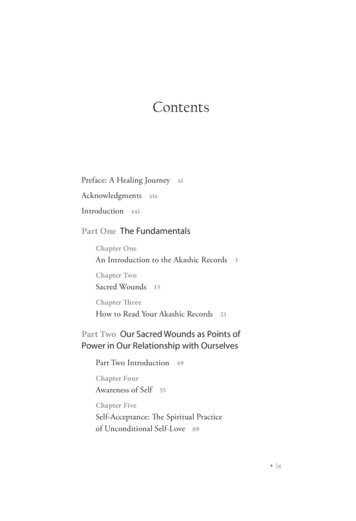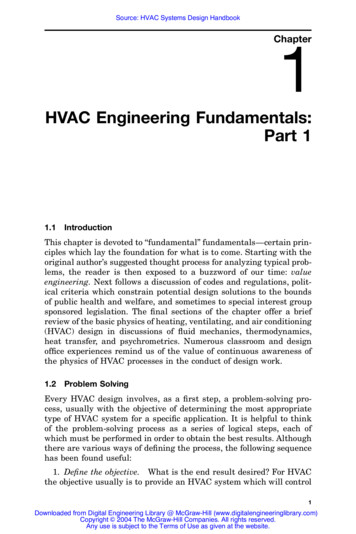
Transcription
Source: HVAC Systems Design HandbookChapter1HVAC Engineering Fundamentals:Part 11.1IntroductionThis chapter is devoted to ‘‘fundamental’’ fundamentals—certain principles which lay the foundation for what is to come. Starting with theoriginal author’s suggested thought process for analyzing typical problems, the reader is then exposed to a buzzword of our time: valueengineering. Next follows a discussion of codes and regulations, political criteria which constrain potential design solutions to the boundsof public health and welfare, and sometimes to special interest groupsponsored legislation. The final sections of the chapter offer a briefreview of the basic physics of heating, ventilating, and air conditioning(HVAC) design in discussions of fluid mechanics, thermodynamics,heat transfer, and psychrometrics. Numerous classroom and designoffice experiences remind us of the value of continuous awareness ofthe physics of HVAC processes in the conduct of design work.1.2Problem SolvingEvery HVAC design involves, as a first step, a problem-solving process, usually with the objective of determining the most appropriatetype of HVAC system for a specific application. It is helpful to thinkof the problem-solving process as a series of logical steps, each ofwhich must be performed in order to obtain the best results. Althoughthere are various ways of defining the process, the following sequencehas been found useful:1. Define the objective. What is the end result desired? For HVACthe objective usually is to provide an HVAC system which will control1Downloaded from Digital Engineering Library @ McGraw-Hill (www.digitalengineeringlibrary.com)Copyright 2004 The McGraw-Hill Companies. All rights reserved.Any use is subject to the Terms of Use as given at the website.
HVAC Engineering Fundamentals: Part 12Chapter Onethe environment within required parameters, at a life-cycle cost compatible with the need. Keep in mind that the cost will relate to theneeds of the process. More precise control of the environment almostalways means greater cost.2. Define the problem. The problem, in this illustration, is to selectthe proper HVAC systems and equipment to meet the objectives. Theproblem must be clearly and completely defined so that the proposedsolutions can be shown to solve the problem.3. Define alternative solutions. Brainstorming is useful here.There are always several different ways to solve any problem. If remodeling or renovation is involved, one alternative is to do nothing.4. Evaluate the alternatives. Each alternative must be evaluatedfor effectiveness and cost. Note that ‘‘doing nothing’’ always has a costequal to the opportunity, or energy, or efficiency ‘‘lost’’ by not doingsomething else.5. Select an alternative. Many factors enter into the selectionprocess—effectiveness, cost, availability, practicality, and others.There are intangible factors, too, such as an owner’s desire for a particular type of equipment.6. Check. Does the selected alternative really solve the problem?7. Implement the selected alternative. Design, construct, and operate the system.8. Evaluate. Have the problems been solved? The objectives met?What improvements might be made in the next design?Many undertakings fail, or are weak in the end result, due to failingto satisfy one or more of these problem-solving increments. There isan art in being able to identify the key issue, or the critical successfactors, or the truly beneficial alternative. Sometimes the evaluationwill be clouded by constraint of time, budget, or prejudice. Occasionally there is an error in assumption or calculation that goes unchecked. The best defense against disappointment is the presence ofgood training and good experience in the responsible group.1.3Value EngineeringValue analysis or value engineering (VE) describes a now highly sophisticated analytical process which had its origins in the materielshortages of World War II. In an effort to maintain and increase production of war-related products, engineers at General Electric developed an organized method of identifying the principal function or service to be rendered by a device or system. Then they looked at thecurrent solution to see whether it truly met the objective in the simplest and most cost-effective way, or whether there might be an alternative approach that could do the job in a simpler, less costly, or moreDownloaded from Digital Engineering Library @ McGraw-Hill (www.digitalengineeringlibrary.com)Copyright 2004 The McGraw-Hill Companies. All rights reserved.Any use is subject to the Terms of Use as given at the website.
HVAC Engineering Fundamentals: Part 1HVAC Engineering Fundamentals: Part 13durable way. The results of the value engineering process now permeate our lives, and the techniques are pervasive in business. Consider our improved automobile construction methods, home appliances, and the like as examples. Even newer technologies such asthose pertaining to television and computers have been improved byquantum leaps by individuals and organizations challenging thestatus quo as being inadequate or too costly.Alphonso Dell’Isolo is generally credited as being the man whobrought value engineering to the construction industry, which industry by definition includes HVAC systems. Dell’Isolo both ‘‘wrote thebook’’1 and led the seminars which established the credibility of thepractice of value engineering in architectural and engineering firmsand client offices across the land.There is a national professional society called SAVE (Society ofAmerican Value Engineers), headquartered in Smyrna, Georgia. Thesociety certifies and supports those who have an interest in and commitment to the principles and practices of the VE process.Value engineering in construction presumes an issue at hand. It canbe a broad concern such as a system, or it can be a narrow concernsuch as a device or component. The VE process attacks the status quoin four phases.1. Gather information. Clearly and succinctly identify the purpose(s) of the item of concern. Then gather information related to performance, composition, life expectancy, use of resources, cost to construct, the factors which comprise its duty, etc. Make graphs, charts,and tables to present the information. Identify areas of high cost infabrication and in operation. Understand the item in general and indetail.2. Develop alternatives. First ask the question, Do we even needthis thing, this service at all? Or are we into it by habit or tradition?If the function is needed, then ask, How else could we accomplish thesame objective? Could we reasonably reduce our expectation or acceptably reduce the magnitude of our effort? Could we eliminate excess material (make it lighter or smaller)? Could we substitute a lessexpensive assembly? Could we eliminate an element of assembly labor? Could we standardize a line of multisize units into just a fewcomponents?In this phase, we learn not to criticize, not to evaluate, for the ‘‘crazies’’ spawn the ‘‘winners.’’ ‘‘Don’t be down on what you are not up on.’’Be creative and open-minded. Keep a written record of the ideas.3. Evaluate the alternatives. Having developed ideas for differentways of doing the same thing, now evaluate the objective and subjective strengths and weaknesses of each alternative. Study performanceDownloaded from Digital Engineering Library @ McGraw-Hill (www.digitalengineeringlibrary.com)Copyright 2004 The McGraw-Hill Companies. All rights reserved.Any use is subject to the Terms of Use as given at the website.
HVAC Engineering Fundamentals: Part 14Chapter Oneversus cost—cost both to construct and to operate. Look for the alternative which will work as well or better for the least overall cost. Thiswill often be a different solution from the original.Note that an analysis effort solely for the purpose of cutting cost isnot really value engineering; for the objective of minimized life cyclecost is often compromised. There are enough buildings in this countrywith fancy finishes and uncomfortable occupants to attest to this assertion. As John Ruskin said many years ago:It is unwise to pay too much but it is worse to pay too little. When youpay too much you lose a little money. When you pay too little you sometimes lose everything, because the thing you bought was incapable ofdoing the thing it was bought to do. The common law of business balanceprohibits paying a little and getting a lot—it can’t be done. If you dealwith the lowest bidder it is well to add something for the risk you run.And if you do that you will have enough to pay for something better.4. Sell the best solution. This ties back into a weakness of manyengineers and designers: They have great ideas, but they have a hardtime getting these ideas implemented. By first understanding the purpose of a device or system, then producing good data to understandcurrent performance, and finally developing an alternative with documented feasibility, the sales effort is greatly supported.Gas forced-air furnaces are an example of an HVAC unit which hasbeen improved over time by value engineering. The purpose of thefurnace now, as before, is to use the chemical energy of a fuel to warmthe environment, i.e., to heat the house. But there is a world of difference between the furnace of the 1930s, with its cast-iron or heavymetal refractory-lined firebox and 4-ft-diameter bonnet, and the hightechnology furnaces of today. Size is down, capacity is up, weight isdown, relative cost is down, fuel combustion efficiency is up, and reliability is debatably up.Variable-speed drives for pumps and fans are devices which havebeen improved to the point of common application. The operating-costadvantages of reduced speed to ‘‘match the load’’ have been knownand used in industry for a long time, but technology has taken its timeto develop reliable, low-cost, variable-speed controllers for commercialmotors, such as variable-frequency drives now used in HVAC applications.If value engineering seems to share some common analytical technique with Sec. 1.2 on problem solving, the dual presentation is intentional. Both discussions are approaches to solving problems, to improving service. The first is an interpretation of a mentor’s example,Downloaded from Digital Engineering Library @ McGraw-Hill (www.digitalengineeringlibrary.com)Copyright 2004 The McGraw-Hill Companies. All rights reserved.Any use is subject to the Terms of Use as given at the website.
HVAC Engineering Fundamentals: Part 1HVAC Engineering Fundamentals: Part 15the second is a publicly documented, formal procedure. The HVACsystem designer will benefit greatly if she or he can commit to ananalytical thought process which defines the problem, proposes solutions, identifies the optimum approach, and finally presents the solution in a credible and compelling way.1.4Codes and RegulationsNo HVAC designer should undertake a design task without first having an awareness of and hopefully a working familiarity with the various codes and ordinances which govern and regulate building construction, product design and fabrication, qualification of engineers inpractice, etc. Codes generally are given the force of law on the basisof protecting the public safety and welfare. Penalties may be appliedto those who violate established codes, and the offending installationmay be condemned and regarded as unsuitable for use by enforcementauthorities. As young design practitioners, we were advised to ‘‘curlup with a good code book’’ until we became thoroughly familiar withits precepts.Codes are particularly definitive regarding a building’s structuralintegrity, electrical safety, plumbing sanitation, fuel-fired equipmentand systems, fire prevention detection and protection, life safety andhandicapped accessibility in buildings, energy conservation, indoor airquality, etc. Each of these areas has an impact on the design of HVACsystems.Particular codes are sufficiently diverse in their adoption and implementation that it is unwise for this book to list any specifics. TheHVAC system designer should simply know that life is not withoutconstraint; that systems will conform to codes, or else a permit to buildand use will be denied; and that willful violation of codes by the designer is done only at great personal risk.The recommended practice for every HVAC design assignment is tomake an initial review of the locally enforced codes and regulations,to become thoroughly familiar with the applicable paragraphs, and toreligiously follow the prescribed practices, even though such an approach seems to stifle creativity.Occasionally code constraints seem to violate or interfere with theobjective of a construction. At these times, it is often possible to request a variance from the authority. There is no guarantee of acceptance, but nothing ventured, nothing gained. Good preparation generates hope and understanding, and differentiates you from theunending stream of charlatans who seek to sidestep codes and regulations for personal financial gain.Downloaded from Digital Engineering Library @ McGraw-Hill (www.digitalengineeringlibrary.com)Copyright 2004 The McGraw-Hill Companies. All rights reserved.Any use is subject to the Terms of Use as given at the website.
HVAC Engineering Fundamentals: Part 16Chapter OneVariance procedures notwithstanding, in general the best idea is toknow the codes and to design within them. See Ref. 2 for further discussion of this topic.1.5Fluid Mechanics*Fluid mechanics, a fundamental area of physics, has to do with thebehavior of fluids, both at rest and in motion. It deals with propertiesof fluids, such as density and viscosity, and relates to other aspects ofphysics, such as thermodynamics and heat transfer, which add theissues of energy to the functions of the basic fluid flow. For this briefreminder paragraph, remember:䡲 The static pressure at a point in a fluid system is directly propor-tional to the density of the fluid and to the height of the fluid column. Static
HVAC Engineering Fundamentals: Part 1 3 durable way. The results of the value engineering process now per-meate our lives, and the techniques are pervasive in business. Con-sider our improved automobile construction methods, home appli-ances, and the like as examples. Even newer technologies such as those pertaining to television and computers have been improved by quantum leaps by


